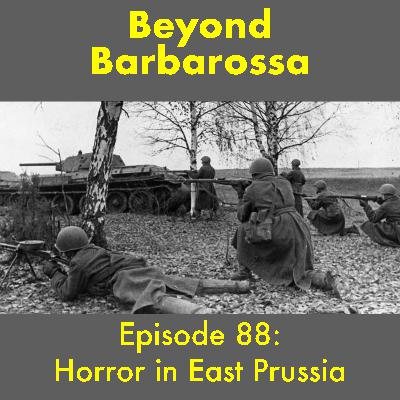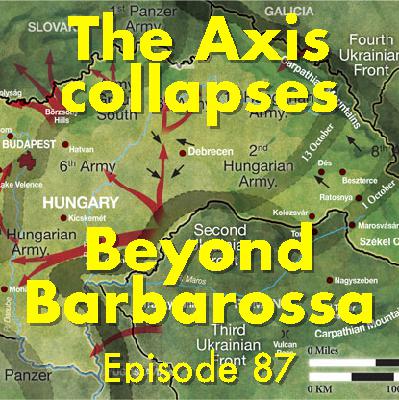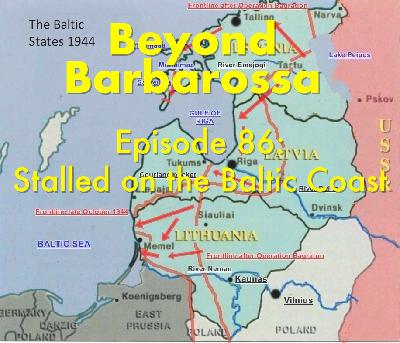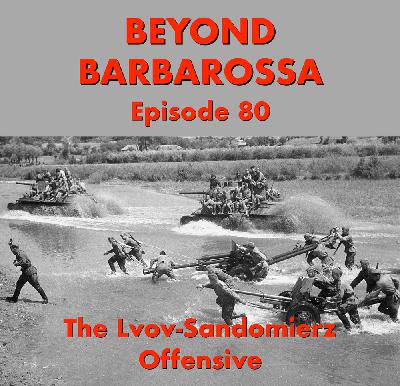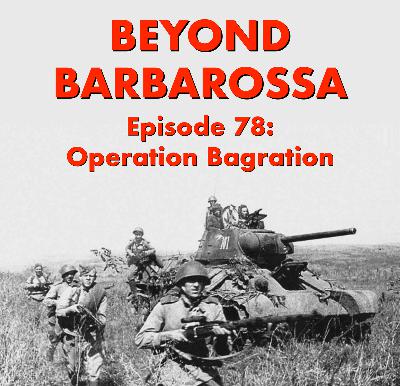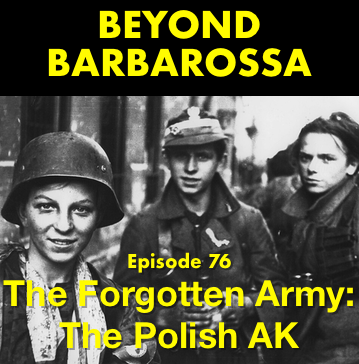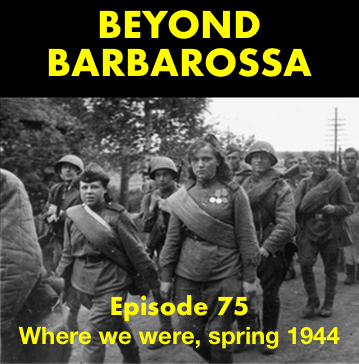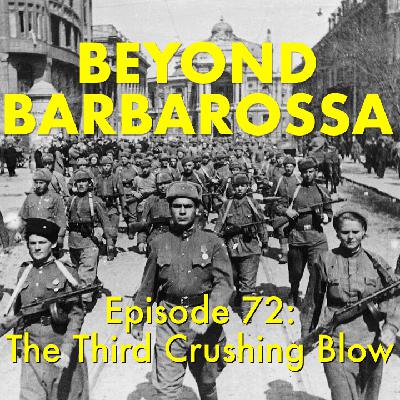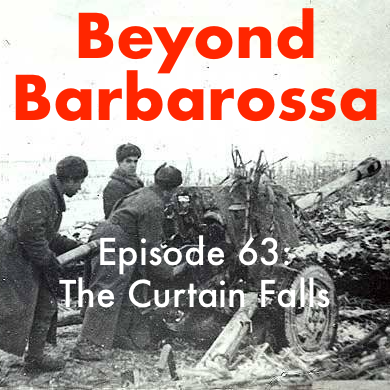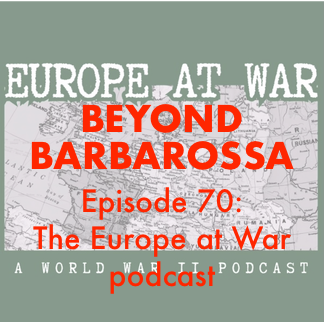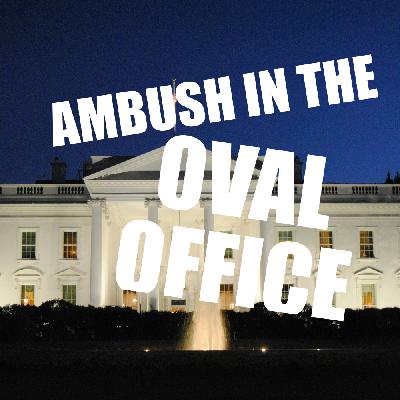Discover Beyond Barbarossa: The Eastern Front of World War 2
Beyond Barbarossa: The Eastern Front of World War 2

Beyond Barbarossa: The Eastern Front of World War 2
Author: Scott Bury
Subscribed: 88Played: 3,325Subscribe
Share
© Copyright 2022 All rights reserved.
Description
You know about Stalingrad, the siege of Leningrad, maybe Kursk. But how well do you know the history of the ”Russian front” of the Second World War? Join this detailed description of the largest part of WW2 in Europe, the titanic clash between tyrants Hitler and Stalin.
94 Episodes
Reverse
In October 1944, the Red Army entered East Prussia, the heart of German militarism. Horrific war crimes ensued.
Map 1: The Red Army’s advances all across the broad front
Map 2a: European Theatre, 1 October 1944
Map 2b: European Theatre, 1 November 1944
Map 3a: The Pacific Theatre, 1 October 1944
Map 3b: The Pacific Theatre, 1 November 1944
Map 4: The Gumbinnen Operation
Historical photos
Konigsberg Castle before World War 1
German officers find evidence of massacre at Nemmersdorf, East Prussia
Civilians killed at Nemmersdorf, 1944
Sources
Antony Beevor, The Second World War. New York, NY, USA: Little, Brown and Company, 2012.
Evan Mawdsley, Thunder in the East: The Nazi-Soviet War, 1941–1945. London: Bloomsbury Academic, 2016.
Pat McTaggart, "Goldap Operation: Soviets in the Prussian Heartland,” in WWII History, vol. 14, No. 2, February 2015. Cited in Warfare History Network, February 2015, https://warfarehistorynetwork.com/article/goldap-operation-soviets-in-the-prussian-heartland/
Anthony Tucker-Jones, Slaughter on the Eastern Front: Hitler and Stalin’s War, 1941–1945. Stroud, Gloucestershire, UK: The History Press, 2017.
Morse code by Thane Brown
Music composed and recorded by Nicolas Bury
In the autumn of 1944, nation after nation abandons the cruel, insane Axis to join the Western Allies or USSR: Romania, Bulgaria, Slovkia … as Finland signs an armistice with the USSR. With the Red Army on the border of Germany itself, Hungary faces the choice: to fight on with, or against, the nazis.
Map 1: The Red Army invades Slovakia
The Dukla Pass is to the right.
Map 2: The Battle of Debrecen
Photos
General (later Marshal) Rodion Malinovsky, 1944
General (later Marshal) Fyodor Tolbukhin, 1944
Marshal Ivan Konev, 1945
Milos Horthy, Regent of Hungary, 1944
Ferenc Szalisi, Leader of the Hungarian Nation, 1944
General Heinz Guderian, Inspector-General of the Army, 1944
By the autumn of 1944, everyone could see which way the Second World War was going — even the Axis commanders. Still, they were able to hold the Red Army back in key locations like Courland and Memel.
Map 1: The Courland and Memel pockets, to the end of 1944
Map 2: The Memel pocket, 1944
Image 1: Hovhannes Bagramyan in 1955
Image 2: Army of Worn Soles, volume 1 of the Eastern Front Trilogy
https://www.amazon.com/Army-Worn-Soles-Scott-Bury/dp/0987914197/
Image 3: Walking Out of War, volume 3 of the Eastern Front Trilogy
https://www.amazon.com/gp/product/1987846052
Sources
Scott Bury, Army of Worn Soles: Volume 1 of The Eastern Front Trilogy. Ottawa: The Written Word Publishing Co., 2014.
Scott Bury, Walking Out of War: Volume 3 of The Eastern Front Trilogy. Ottawa: The Written Word Publishing Co., 2014.
Prit Buttar, The Reckoning: The Defeat of Army Group South, 1944 . Okford, UK: Osprey Publishing, 2020.
Evan Mawdsley, Thunder in the East: The Nazi-Soviet War, 1941–1945. London: Bloomsbury Academic, 2016.
Morse code by Thane Brown
Music composed and recorded by Nicolas Bury
Describing the Eastern Front chronologically gets very difficult in the second half of 1944, because there’s so much happening everywhere, all at the same time.
After the Warsaw Rising, as described in Episode 83, the Red Army surged past its borders into Finland, Estonia, Romania, Bulgaria, and farther.
Meanwhile, the Western Allies are taking France, Belgium and Italy from Hitler. But there is still a lot of fighting and death to come.
Map 1: The Gothic Line, Italy
Map 2: The Continuation War ends, Finland
Map 3: The advance of the Red Army, August 1943–December 1944
Maps 4A and 4B: Advances of the front lines, east and west
4A: 15 August 1944
4B: 1 October 1944
Sources
Antony Beevor, The Second World War. London, UK: Little, Brown and Co., 2012.
Evan Mawdsley, Thunder in the East: The Nazi-Soviet War, 1941–1945. London: Bloomsbury Academic, 2016.
Anthony Tucker-Jones, Stalin’s Revenge: Operation Bagration and the Annihilation of Army Group Centre. Barnsley, South Yorkshire, UK: Pen and Sword Books, 2009.
Morse code by Thane Brown
Music composed and recorded by Nicolas Bury
In summer 1944, "the Red Army’s seemingly unstoppable streamroller took Stanislav in the Carpathian foothills, Bialystok in northern Poland, Dvinsk in Latvia and the Siauliai (also spelt Shaulyai) rail junction between Riga and East Prussia.” — Anthony Tucker-Jones.
Even so, the steamroller suffered ferocious mauling.
If you can transcribe the morse code signal during “What else is happening in the war,” send an email to scott@beyondbarbarossa.ca. If you’re correct, I will send you a free autographed copy of The Eastern Front Trilogy.
Map 1a: The Eastern Front, July 1944
Map 1b: The front, August 1944
Map 2: The Lvov-Sandomierz Offensive, detail
Map 3: The Narva Offensive
Music by Nicolas Bury.
Morse code from Thane Brown.
Some sound effects from Zapsplat.com.
Stalin’s one-two punch against Germany is the Lvov-Sandomierz offensive, hitting in Ukraine as Bagration smashes into Byelorussia. It also lays bare the brutality within the Red Army.
Map 1: The Byelorussian Balcony
Map 2: The Lvov-Sandomierz Operation
Map 3: The Eastern Front, 15 June 1944
Map 4: The Eastern Front, 15 July 1944
Map 5: The Eastern Front, 15 August 1944
Ivan Konev, commander, 1st Ukrainian Front
Lt. General Pavel Rybalko, commander, 3rd Guards Tank Army
Josef Harpe, Commander, Army Group North Ukraine
Sources:
Antony Beevor, The Second World War. London, UK: Little, Brown and Co., 2012.
Prit Buttar, Retribution: The Soviet Reconquest of Central Ukraine, 1943. Oxford, UK: Osprey Publishing, 2019.
Evan Mawdsley, Thunder in the East: The Nazi-Soviet War, 1941–1945. London: Bloomsbury Academic, 2016.
Anthony Tucker-Jones, Stalin’s Revenge: Operation Bagration and the Annihilation of Army Group Centre. Barnsley, South Yorkshire, UK: Pen and Sword Books, 2009.
Today, Beyond Barbarossa fulfills a promised made at the start of this podcast: a meaningful donation to help refugees of Russia’s unjustifiable war of aggression against Ukraine, to the Ukraine Humanitarian Appeal.
We’re joined by Valeriy Kostyuk, Executive Director of the Canada-Ukraine Foundation, which runs the appeal.
Links
Canada-Ukraine Foundation
Ukraine Humanitarian Appeal
Medical javelins
Thornhill Medical and their MOVES SLC mobile life-support system.
Did the Lend-Lease program save the Soviet Union? For the Season 3 finale, Angus Wallace of the World War 2 podcast joins to offer a nuanced interpretation.
Angus Wallace, host and producer of The World War 2 podcast
The Lend-Lease Act
British Valentine tanks to be sent to USSR under Lend-Lease, 1942.
The Bell P-39 Aircobra, one of the fighters the U.S. sent to the Soviet Union under Lend-Lease.
A Hawker Hurricane fighter sent for the Red Air Force.
Fleets of Studebaker, Ford and Chevrolet trucks sent to the Soviet Union under Lend-Lease.
U.S. jeeps sent to the Soviet Union under Lend-Lease made Life magazine.
The Western Allies sent millions of tons of food aid to the Soviet Union during World War 2.
The Red Army moved tanks to the front by rail, on flatcars, with locomotives often supplied by the U.S. Much of the rail was also supplied by the U.S.
The “Big Three,” Churchill, Roosevelt and Stalin, at the Yalta Conference in 1945. Roosevelt was clearly unwell by this point. This conference decided the post-war division of Europe between West and East, meaning USSR.
Maps
Map 1: Lend-Lease shipping routes
Lend-Lease shipping literally spanned the globe.
Map 2: The Arctic route (polar projection)
Map 3: The Persian Corridor.
Ships arrived in Persian Gulf ports, then goods were transshipped by train through Iran to be loaded onto ships again at the Caspian Sea.
Map 4: The Pacific route.
Note the proximity to Japan as ships approach Vladivostok in the Russian Far East.
The USSR’s answer to D-Day in June 1944 takes the Germans by surprise—and annihilates a whole army group.
Map 1: The Vyborg-Petrozavodsk Offensive, the end of the Continuation War against Finland
Map 2: The "Byelorussian Balcony”
Map 3: Attack on Vitebsk
Map 4: Rokossovsky’s attack on Bobruisk
Map 5: Attack on Minsk
Photos
Minsk, July 1944
Destroyed German armour on road to Minsk
German POWs in Moscow, July 1944
Soviet and Polish Home Army (AK) soldiers together in Vilnius, July 1944. The AK soldiers were then arrested by the NKVD and sent to Gulags.
Author Craig W.H. Luther joins us to compare two anniversaries on the same date, 22 June, three years apart: Operations Barbarossa in 1941, and Operation Bagration in 1944.
Craig W.H. Luther
The First Day on the Eastern Front: Germany Invades the Soviet Union, June 22, 1941
Barbarossa Unleashed: The German Blitzkrieg through Central Russia to the Gates of Moscow, June–December 1941
Guderian’s Panzers: From Triumph to Defeat on the Eastern Front, 1941
Map 1: Operation Barbarossa, 22 June 1941
Map 2: The Byelorussian balcony, June 1944
Map 3: Operation Blue, summer 1942
Craig W.H. Luther Archive: https://www.barbarossa1941.com/
A major army, 400,000 strong, made a major difference in World War 2. Yet it doesn’t get enough attention in the West (nor, unfortunately, on this podcast). It’s the Armia Krajowa, the Polish Home Army. From exposing the Holocaust, to breaking the German Enigma Code, to helping destroy V-2 rockets, the AK bridged the Eastern and Western Fronts of the Second World War.
Map 1: German invasion of Poland, September 1939
Map 2: Soviet invasion of Poland, September 1939
Historic photos
Flag of the Armia Krajowa, Polish Home Army
Gen. Michal Tadeusz Tokarzewski-Karaszewicz second-in-command of the Army of Warsaw
Wladyslaw Sikorski, Prime Minister of Polish Government-in-Exile
Elzbieta Zawacka, “Agent Zo"
Elzbieta Zawacka’s story, Agent Zo by Clare Mulley
Jewish resistance fighters in the Warsaw Ghetto uprising, 1943
SS burns the Warsaw Ghetto, 1943
SS transports Jewish survivors of the Warsaw Ghetto to extermination camps
AK fighters
Polish Boy Scouts in AK, 1944
Women members of AK
Enigma, the German coding machine
The three Polish cryptologists who broke the German Enigma code: left to right, Marian Rejewski, Jerzy Rozycki, and Henryk Zygalski
Sources:
Antony Beevor, The Second World War. London, UK: Little, Brown and Co., 2012.
Richard Lukas, The Forgotten Holocaust. New York: Hippocrene Books, 1986, and University of Kentucky Press, 1986.
Home Army Museum/Muzeum Armii Krajowej, https://muzeum-ak.pl/
Wikipedia, various pages.
It’s been a year of stunning, swift change on the Eastern Front of World War 2. And momentous events are coming soon — so it’s high time for a recap of the past year.
Links
Episode 50: Looking back, taking stock https://beyondbarbarossa.podbean.com/e/looking-back-taking-stock-episode-50/
The Battle(s) of Kursk
Episode 51: Summer 1943 planshttps://beyondbarbarossa.podbean.com/e/summer-1943-plans-season-3-opener-episdoe-51/
Episode 52: Zitadelle, the Battle of Kursk, Part 2https://beyondbarbarossa.podbean.com/e/zitadelle—the-battle-of-kursk-part-2-episode-52/
Episode 53: The Battle of Kursk, part 3https://beyondbarbarossa.podbean.com/e/the-battle-of-kursk-part-3-episode-53/
Episode 67: The Red Army has the momentum https://beyondbarbarossa.podbean.com/e/the-red-army-has-the-momentum-episode-67/
Friedrich Paulus, commander of the German 6th Army in 1942, the only German Field Marshal ever to surrender
Maps
Map 1: The Axis’ high-water mark, Europe
Map 2: Axis’ high-water mark, Asia-Pacific
Map 3: North Africa, summer 1942
Map 4: Germans advance to the Volga
Map 5: Operation Winter Storm
Map 6: 4th Battle of Kharkiv
Map 7: Battle of Kursk
Map 8: Operation Little Saturn
Map 9: Rzhev Salient
Map 10: Korsun/Cherkassy pocket
Map 11: Crushing blows: the front lines in the Eastern Front, April 1944
On 2 May 1945, Red Army soldiers raised the Soviet Red Banner with hammer and sickle on the cupola of the Reichstag in Berlin. For the 80th anniversary of that famous photograph, Anthony Tucker-Jones joins the ‘cast to discuss the Fall of Berlin.
“Raising a Flag over the Reichstag” shows Red Army soldier Aleksei Kovalev hoisting the Red Banner over the cupola of the Reichstag. This was staged on 2 May 1945, after the Red Army had taken full control of the building.
Historian and author Anthony Tucker-Jones
Two of his books
Learn more about Anthony Tucker-Jones on his website.
Map 1: Three Red Army Fronts advance on Berlin
Map 2: The final battle for Berlin
Movies cited:
Downfall, in German with subtitles
Come and See, in Russian
This episode, we jump forward for the 80th anniversary of the end of the Second World War in Europe. To guide us through the battles for Berlin, we are joined by the author of The Fall of Berlin: The Final Days of Hitler’s Evil Regime.
Author Anthony Tucker-Jones
His website and books: https://atuckerjones.com/
Maps
Map 1: The front lines, 15 April 1945
Map 2: The front lines, 1 May 1945
Map 3: Final operations, April-May 1945
Map 4: The Red Army’s Vistula-Oder offensive
Map 5: 1st Belorussian Front’s drive through the Seelow Heights to Berlin
Map 6: The battles for Berlin at the end of April 1945
Books
In 1944, the Red Army delivers its third crushing blow on the Axis forces in eastern Europe: two major offensives to recapture the rest of Ukraine, and the Crimean peninsula.
Map 1: Northern Black Sea coast and southern Ukraine
The range where the two mighty blows were delivered. Ploesti, Romania is to the far left of the map, just north of Bucharest.
Map 2:
Map by Scott Bury
Map 3: The Red Army’s Crimean offensive, 1944
Image 1: Issa Pliyev, Commander, Cavalry-Mechanized Group
The Red Army, 4th Guards Cavalry Corps advancing across southern Ukraine, 1944
Miklós Horthy, Regent of Hungary, with Adolf Hitler in Budapest, 1938
The Red Army marches into “liberated” Odesa, 1944
Note the women soldiers in the ranks.
Sources:
Prit Buttar, The Reckoning: The Defeat of Army Group South, 1944. Oxford, UK: Osprey Publishing, 2020.
Evan Mawdsley, Thunder in the East: The Nazi-Soviet War, 1941–1945. London: Bloomsbury Academic, 2016.
Anthony Tucker-Jones, Slaughter on the Eastern Front: Hitler and Stalin’s War 1941–1945. Stroud, Gloucestershire, UK, The History Press, 2017.
Wikipedia: The Crimean Offensive https://en.wikipedia.org/wiki/Crimean_offensive
— The Odesa Offensive https://en.wikipedia.org/wiki/Odessa_Offensive
From the beginning of Russia’s illegal and brutal assault on sovereign Ukraine, Ukraine: The Latest has covered the war every week day. Francis Dearnley, Executive Editor for Audio for Ukraine: The Latest, joins the podcast to look at the historical links and parallels with the Eastern Front of World War 2.
Francis Dearnley, Executive Editor for Audio, Ukraine: The Latest, from The Telegraph
Ukraine: The Latest, daily podcast from The Telegraph
David Knowles, creator of the Ukraine: The Latest podcast
Links
Ukraine: The Latest
on Apple https://podcasts.apple.com/ca/podcast/ukraine-the-latest/id1612424182
and available on all major podcast platforms.
Francis Dearnley’s interview with Ukrainian President Volodymyr Zelenskyy
Winston Churchill’s World War II memoirs
Guy Sajer’s The Forgotten Soldier
Antony Beevor’s Berlin 1945
Episode 63: at the end of 1943, the situation for nazi Germany and communist USSR on the Eastern Front is radically different from the end of 1942. Plus, the Cairo and Tehran Conferences promise to reshape the geo-political world.
Map 1: The Red Army advances to, and past the Wotan Line
Map 2: The front lines, 15 November 1943
Map 3: The front lines, 31 December 1943
Historical photos: The German Panther (Panzer V) vs. the Soviet T-34-85
Soviet photo loading artillery at Nikopol bridgehead
Sources:
Antony Beevor, The Second World War. London, UK: Little, Brown and Co., 2012.
Prit Buttar, Retribution: The Soviet Reconquest of Central Ukraine, 1943. Oxford, UK: Osprey Publishing, 2019.
Evan Mawdsley, Thunder in the East: The Nazi-Soviet War, 1941–1945. London: Bloomsbury Academic, 2016.
Beyond Barbarossa is no longer the only podcast focusing on the Eastern Front of World War II. David Sumner, host and producer of the Europe at War podcast, joins to discuss the Battle of the Halbe Pocket.
The Europe at War podcast on all platforms: https://pohttps://tr.ee/faCigcYaE5
David Sumner, podcaster
Map: The Battle of the Halbe Pocket, April 1945
Photos from David Sumner
The Halbe forest, 2025
A defensive hole dug in the floor of the Halbe Forest
A bullet shell with the round still inside it, the outer shell which corroded from being in the ground for eight decades.
The comb David Sumner found in the Halbe Forest
From the Halbe Pocket battle
General Theodor Busse
General Walther Wenke
Arden nazi Ferdinand Shorner
Russian occupation of Ukraine today is not the first time. Here are some readings that can make it real for today’s listeners.
Map: Ukraine under occupation, 1941–1943
Source: Ukraine, A Historical Atlas by Paul Robert Magosci and Geoffrey J. Matthews
Sources
Lubomyr Luciuk, The Galicia Division: They Fought for Ukraine. The Kashtan Press, 2023.
Scott Bury, Under the Nazi Heel. Ottawa, ON: The Written Word Communications Co., 2016.
A special episode of Beyond Barbarossa.
What happened in Washington DC on 28 February 2025 has echoes of 1938, and ominous omens for the future.


